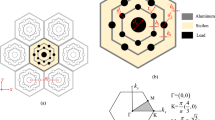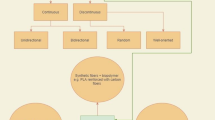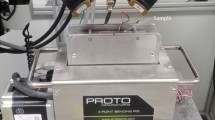Abstract
The Prony series models have been widely utilized in characterizing the linear viscoelastic properties of asphalt mixtures. However, the determination of the time coefficients, as a crucial step in identifying the Prony series coefficients, is based on empirical adjustments and time-consuming selections. In order to overcome the drawbacks of the existing methods, this study proposes a method for determining the optimal relaxation time range (ORTR) based on the continuous relaxation spectrum method, which is then utilized to identify the Prony series coefficients. There are four major steps in the proposed method: (1) establish the continuous relaxation spectrum by applying the inverse Stieltjes transform to the storage modulus model; (2) set trial groups of the relaxation time range on the basis of the relaxation time corresponding to the peak value of the continuous relaxation spectrum; (3) identify the ORTR through comparing the characteristic number of terms of each trial group; and (4) determine the Prony series coefficients based on the relationship between the relaxation strength and the relaxation time. The proposed method is validated by using complex modulus data of two types of asphalt mixtures at four test temperatures and six loading frequencies. The results show that: (1) the midpoint of the ORTR is close to the relaxation time corresponding to the peak point of the continuous relaxation spectrum; and (2) the total number of terms in the Prony series model developed from the ORTR is less than 30 and the model errors are less than 3.2%.










Similar content being viewed by others
References
Zhang Y, Luo R, Lytton RL (2012) Characterizing permanent deformation and fracture of asphalt mixtures by using compressive dynamic modulus tests. J Mater Civ Eng 24(7):898–906
Zhang Y, Luo R, Lytton RL (2013) Characterization of viscoplastic yielding of asphalt concrete. Constr Build Mater 47:671–679
Underwood BS, Baek C, Kim Y (2012) Simplified viscoelastic continuum damage model as platform for asphalt concrete fatigue analysis. J Transp Res Board 2296:36–45
Chailleux E, Roche CDL, Piau JM (2011) Modeling of complex modulus of bituminous mixtures measured in tension/compression to estimate secant modulus in indirect tensile test. Mater Struct 44(3):641–657
De Araujo PC, Soares JB, De Holanda AS et al (2010) Dynamic viscoelastic analysis of asphalt pavements using a finite element formulation. Road Mater Pavement Des 11(2):409–433
Wan C, Zhang X, Wang L et al (2012) Three-dimensional micromechanical finite element analysis on gauge length dependency of the dynamic modulus of asphalt mixtures. Road Mater Pavement Des 13(4):769–783
Zhang Y, Birgisson B, Lytton RL (2016) Weak form equation-based finite-element modeling of viscoelastic asphalt mixtures. J Mater Civ Eng 28(2):4015115. https://doi.org/10.1061/(ASCE)MT.1943-5533.0001395
Park SW, Schapery RA (1998) Methods of interconversion between linear viscoelastic material functions. Part I—a numerical method based on Prony series. Int J Solids Struct 36(11):1653–1675
Zhao Y, Ni Y, Zeng W (2014) A consistent approach for characterising asphalt concrete based on generalised Maxwell or Kelvin model. Road Mater Pavement Des 15(3):674–690
Sun Y, Huang B, Chen J (2015) A unified procedure for rapidly determining asphalt concrete discrete relaxation and retardation spectra. Constr Build Mater 93:35–48
Kim YR, Park SW (2001) Fitting Prony-series viscoelastic models with power-law pres-moothing. J Mater Civ Eng 13(1):26–32
Kim R, Chehab G, Schapery R et al (2003) Characterization of asphalt concrete in uniaxial tension using a viscoelastoplastic continuum damage model. J Assoc Asphalt Paving Technol 72:315–355
Gibson N, Schwartz C, Schapery R et al (2003) Viscoelastic, viscoplastic, and damage modeling of asphalt concrete in unconfined compression. J Transp Res Board 1860:3–15
Schapery RA (1961) A simple collocation method for fitting viscoelastic models to experimental data. GALCIT SM 61-32A. Pasadena, CA: California Institute of Technology
Cost TL, Becker EB (1970) A multi-data method of approximate Laplace transform inversion. Int J Numer Methods Eng 2(2):207–219
Winter HH (1997) Analysis of dynamic mechanical data: inversion into a relaxation time spectrum and consistency check. J Non-Newton Fluid Mech 68(2):225–239
Tschoegl NW, Emri I (1993) Generating line spectra from experimental responses. Part II: storage and loss functions. Rheol Acta 32(3):322–327
Ramkumar DHS, Caruthers JM, Mavridis H et al (1997) Computation of the linear viscoelastic relaxation spectrum from experimental data. J Appl Polym Sci 64(11):2177–2189
Pacheco JEL, Bavastri CA, Pereira JT (2015) Viscoelastic relaxation modulus characterization using Prony series. Lat Am J Solids Struct 12(2):420–445
Sun Y, Chen J, Huang B (2015) Characterization of asphalt concrete linear viscoelastic behavior utilizing Havriliak-Negami complex modulus model. Constr Build Mater 99(1):226–234
Bhattacharjee S, Swamy AK, Daniel JS (2012) Continuous relaxation and retardation spectrum method for viscoelastic characterization of asphalt concrete. Mech Time Depend Mater 16(3):287–305
Liu H, Luo R, Lv H (2018) Establishing continuous relaxation spectrum based on complex modulus tests to construct relaxation modulus master curves in compliance with linear viscoelastic theory. Constr Build Mater 165:372–384
Luo R, Lv H, Liu H (2018) Development of Prony series models based on continuous relaxation spectrums for relaxation moduli determined using creep tests. Constr Build Mater 168:758–770
Liu H, Luo R (2017) Development of master curve models complying with linear viscoelastic theory for complex moduli of asphalt mixtures with improved accuracy. Constr Build Mater 152:259–268
G Sayegh (1967) Viscoelastic properties of bituminous mixes. In: Proceedings of the 2nd international conference on the structural design of asphalt pavements, pp 614–627
Chailleux E, Ramond G, Such C et al (2006) A mathematical-based master-curve construction method applied to complex modulus of bituminous materials. Road Mater Pavement Des 7(sup1):75–92
Pellinen TK, Witczak MW, Bonaquist RF (2004) Asphalt mix master curve construction using sigmoidal fitting function with non-linear least squares optimization. Geotechnical Special Publication 123:83–101
Zhu H, Sun L, Yang J et al (2011) Developing master curves and predicting dynamic modulus of polymer-modified asphalt mixtures. J Mater Civ Eng 23(2):131–137
Zhang Y, Ma T, Ling M et al (2019) Predicting dynamic shear modulus of asphalt mastics using discretized-element simulation and reinforcement mechanisms. J Mater Civ Eng 31(8):04019163. https://doi.org/10.1061/(ASCE)MT.1943-5533.0002831
Zhao Y, Liu H, Bai L et al (2013) Characterization of linear viscoelastic behavior of asphalt concrete using complex modulus model. J Mater Civ Eng 25(10):1543–1548
Booij HC, Thoone GPJM (1982) Generalization of Kramers–Kronig transforms and some approximations of relations between viscoelastic quantities. Rheol Acta 21(1):15–24
Luo R, Liu H (2017) Improving the accuracy of dynamic modulus master curves of asphalt mixtures constructed using uniaxial compressive creep tests. J Mater Civ Eng 29(7):04017032
Ferry JD (1980) Viscoelastic properties of polymers, 3rd edn. Wiley, New York
Acknowledgements
The authors acknowledge the financial support given by the National Key R&D Program of China (Grant No. 2016YFE0202400) and the National Natural Science Foundation of China (Grant No. U1633201).
Author information
Authors and Affiliations
Corresponding author
Ethics declarations
Conflict of interest
There is no conflict of interest declared by the authors.
Additional information
Publisher's Note
Springer Nature remains neutral with regard to jurisdictional claims in published maps and institutional affiliations.
Rights and permissions
About this article
Cite this article
Lv, H., Liu, H., Tan, Y. et al. Improved methodology for identifying Prony series coefficients based on continuous relaxation spectrum method. Mater Struct 52, 86 (2019). https://doi.org/10.1617/s11527-019-1386-1
Received:
Accepted:
Published:
DOI: https://doi.org/10.1617/s11527-019-1386-1




